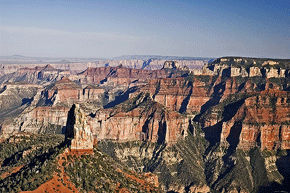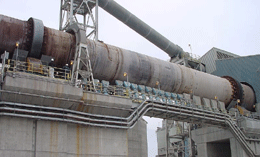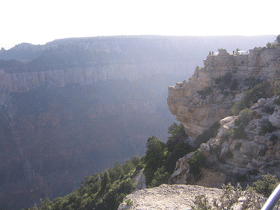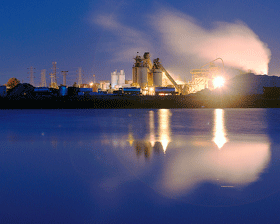Bad Air in a Big Canyon
Air Date: Week of July 3, 2009

The North Rim of the Grand Canyon.
Cement plants are big air polluters and the Environmental Protection Agency is in the process of tightening its regulations on plant emissions. These new rules are coming just as cement giant Cemex wants to build a new plant in Arizona that would create jobs but also potentially cloud the view of the Grand Canyon. Arizona Public Radio’s Laurel Morales reports.
Transcript
YOUNG: The Environmental Protection Agency plans to firm up its rules on cement plants. Cement kilns pump dust and soot into the air along with toxic emissions like mercury. EPA's regulations come just as cement giant Cemex hopes to start up a new kiln in Arizona.

A medium-sized modern cement kiln.
[CHIRPING OF THE METER]
MORALES: For eighteen years it’s been Carl Bowman’s job to guard the 100-mile view at Grand Canyon. He leans over what looks like a large telescope to check the day’s visibility on an air monitor.
BOWMAN: On our very best days you know those days that just take your breath away you walk up to the rim, you look across, the North Rim’s ten miles away, and the colors over there are bright. The shadows and textures are nice and crisp.
[TOURIST CHATTER]
MORALES: Nearby, tourists pose for pictures at the popular overlook and take in the glorious crags, cliffs and brilliant red rocks in every hue.
BOWMAN: It feels almost like you can reach out and touch it. But as the haze starts to build up the colors start to get muted, the textures start to kind of flatten out. On those haziest days you can look across and see the North Rim but what you’re seeing is just this looming blue mass on the other side of the canyon.
MORALES: Whether wind direction and smog blown in from as far away as Los Angeles and Mexico can each affect the view.Bowman says the view has noticeably improved over the last two decades thanks to the Clean Air Act. The law forced two power plants that flanked the Canyon to make big changes. One installed expensive scrubbers; the other closed.
But the proposed cement plant could be a step backwards.
BOWMAN: Any time there’s a proposal for a new facility close to the park, of course we’re concerned, because when we look at the pollution problems that we see within the park, we find that most of them are caused by air pollutants that are actually generated upwind from us.
MORALES: Cemex spokeswoman Jennifer Borgen says the company plans to build an environmentally friendly plant. And she points out federal law protects air quality at national parks.
BORGEN: It’s plain and simple the plant will need to meet the strictest emissions requirements ever written and enforced by the state and federal agencies because it’s close to the Grand Canyon. If it cannot, it will not receive the permit or not be allowed to operate. It’s that simple.
MORALES: Cemex plans to burn coal and petroleum coke to fuel the plant. Coke is a byproduct of oil refining that looks like asphalt run through a coffee grinder.
Cement plants also cook limestone in kilns five times hotter than pizza ovens. Each step can emit pollutants, especially nitrogen oxide, sulfur dioxide and particles.
Northern Arizona University environmental engineer Bill Auberle spends a lot of his time monitoring the air quality at Grand Canyon. He says Cemex needs to provide the details.AUBERLE: My concern is this, that the Clean Air Act of the United States says that no man-made air pollution shall impair visibility at the Grand Canyon National Park and other parks. Zero! We’re not to be fouling the air at Grand Canyon.
MORALES: And Auberle points out Cemex has a history of running afoul with the Environmental Protection Agency. Most recently the company agreed to pay two million dollars to resolve complaints in California.
AUBERLE: Cemex does not have a strong environmental track record. They talk about sustainability and their commitment to a greener environment. But it will take all of that and perhaps more to own and operate a Portland cement plant as they have proposed it.
MORALES: The technology does exist to build a clean cement plant but it’s expensive. And the industry isn’t flush right now. Cemex’s sales are down 40 percent compared to last year. If the EPA requires retrofitting, that will be expensive. But Cemex’s Jennifer Borgen says the company is both bullish on the business and committed to a clean facility.
BORGEN: We know that the economy’s going to come back. We know it’s going to bounce back and demand before the recession started in Arizona was very robust. Cement had to be imported into the state—whether it’s road building or home building or road repairs or bridge repairs.
MORALES: Politics have shifted in Arizona since Governor Janet Napolitano went to work for the Obama administration as Homeland Security Chief. A new environmental director and governor want to attract more industry and jobs to the state. And Arizona lawmakers want fewer environmental restrictions.

The North Rim of the Grand Canyon.
BOWMAN: It says that we will protect the resources within the national parks from damage caused by air pollution. But the Clean Air Act gives us virtually no authority to do anything about air pollution. Instead the act gives that authority to the states and the tribes.
MORALES: So he says working with the state will be critical to protecting the air at the park.
Cemex is now seeking its permit. Once the company files a formal plan, a team of national park specialists will be able to model possible effects. Then state and federal officials will decide whether Cemex can build.
For Living on Earth I’m Laurel Morales at Grand Canyon.
[MUSIC: Slim Gaillard “Cement Mixer” from The Legendary McVouty (Hep Records, Reissue 2000)]
Links
Living on Earth wants to hear from you!
Living on Earth
62 Calef Highway, Suite 212
Lee, NH 03861
Telephone: 617-287-4121
E-mail: comments@loe.org
Newsletter [Click here]
Donate to Living on Earth!
Living on Earth is an independent media program and relies entirely on contributions from listeners and institutions supporting public service. Please donate now to preserve an independent environmental voice.
NewsletterLiving on Earth offers a weekly delivery of the show's rundown to your mailbox. Sign up for our newsletter today!
 Sailors For The Sea: Be the change you want to sea.
Sailors For The Sea: Be the change you want to sea.
 The Grantham Foundation for the Protection of the Environment: Committed to protecting and improving the health of the global environment.
The Grantham Foundation for the Protection of the Environment: Committed to protecting and improving the health of the global environment.
 Contribute to Living on Earth and receive, as our gift to you, an archival print of one of Mark Seth Lender's extraordinary wildlife photographs. Follow the link to see Mark's current collection of photographs.
Contribute to Living on Earth and receive, as our gift to you, an archival print of one of Mark Seth Lender's extraordinary wildlife photographs. Follow the link to see Mark's current collection of photographs.
 Buy a signed copy of Mark Seth Lender's book Smeagull the Seagull & support Living on Earth
Buy a signed copy of Mark Seth Lender's book Smeagull the Seagull & support Living on Earth



